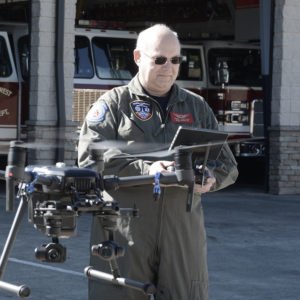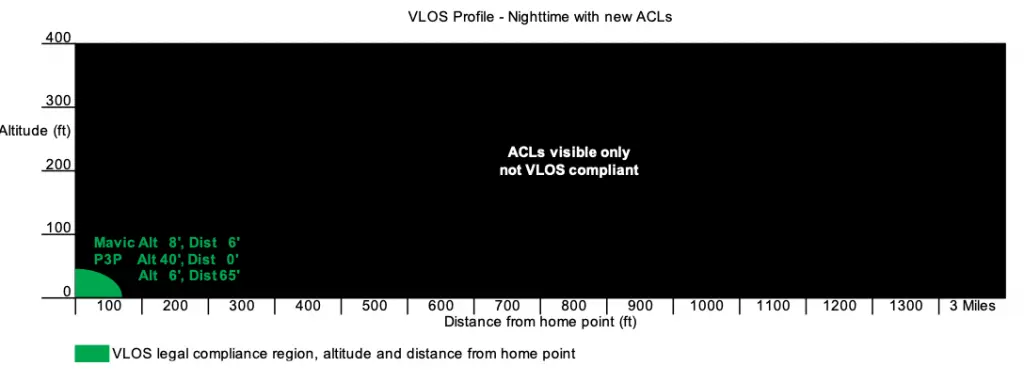 In this column, Steve makes sure drone pilots know they’re using the correct lights for night flight; and are flying compliant with VLOS requirements.
In this column, Steve makes sure drone pilots know they’re using the correct lights for night flight; and are flying compliant with VLOS requirements.
The following is one of an educational series for drone pilots by Steve Rhode, Chief Pilot with the Wake Forest Fire Department and the North Carolina Public Safety Drone Academy, and founder of Public Safety Flight, a website dedicated to information about the use of unmanned aircraft systems (UAS), UAVs, aircraft, and drones in public safety. (Not to be contrued as legal advice: please see details at the FAA government site. Opinions are the author’s.)
This article was originally published on PSflight.org, and is part 1 of a 2 part series on day and night VLOS flights.
“How far can I fly at night using my strobe lights?” is a question many just get wrong. Let’s look at the facts.
Your UAS is required to have anti-collision lighting on it that can be seen for three statute miles. Unfortunately, some incorrectly assume that means they can fly for three miles at night.
To fly within the regulations, your actual night flight distance is probably about a hundred feet or less unless your operational flight area is illuminated.
Anti-Collision Lights
Let’s start with the anti-collision lights (ACL) or strobes. First off, you can’t rely on what the manufacturer of the strobes states. There are no ACLs manufactured that are officially compliant with an FAA regulation since there is no Technical Standard Order to comply with for ACLs.
In 2018 I wrote all about the process required for a UAS pilot to certify their strobes met the visible requirements for three statute miles. Read Did You Know Your Anti-Collision Lights Are Not Compliant?
The post contains advice on how to certify the ACLs are compliant, the logbook entry to make, and each pilot’s responsibilities to ensure compliance.
So Can I Rely on the ACLs for Night Flight?
No. ACLs are not for use by the UAS pilot. They are there to give manned aircraft a visual alert of the UAS location.
The FAA Advisory Circular 107-2A is very clear about this in section 5.9.3 that details Visual Line of Sight (VLOS) night flight.
“VLOS at Night. Prior to a small UAS operation at night, the remote PIC should ensure he or she will be able to keep the small unmanned aircraft within the intended area of operation and within VLOS for the duration of the operation. In almost all cases involving operations at night, the remote PIC may need to restrict the operational area of the small unmanned aircraft. Reduced lighting and contrast at night may make it difficult for remote pilots to fulfill the requirements of § 107.31(a), requiring remote pilots to maintain the capability of visually discerning the location, attitude, altitude, and direction of the flight of the aircraft. A remote pilot cannot solely rely on the small unmanned aircraft’s anti-collision lighting, Ground Control Station (GCS) telemetry data displays, or a combination of the two for compliance with § 107.31.”
In case this important section was lost in the paragraph:
A remote pilot cannot solely rely on the small unmanned aircraft’s anti-collision lighting, Ground Control Station (GCS) telemetry data displays, or a combination of the two for compliance with § 107.31.
Drone pilot Robert Zarrancia did extensive work and testing on both day and night VLOS flights. It would help if you read How Far Can I Legally Fly My Drone and Maintain VLOS?
The actual field tests demonstrated that to meet the requirements of sections 5.9.3 and § 107.31 night flight “requiring remote pilots to maintain the capability of visually discerning the location, attitude, altitude, and direction of the flight of the aircraft” was limited to no more than 100 feet from the Remote Pilot in Command (RPIC).
And why is the distance so short? It’s dark out and you can’t see the drone to determine the mandatory flight requirements since you cannot use the ACLs or Ground Control Station (GCS) telemetry data displays solely for compliant flight.
If you feel the ACLs allow you to meet the requirements of 107.31 and aid in your compliance, then go out and test it yourself.
Here is Test Form you can use to determine the accuracy of your estimates. Once you have documented your ability to accurately determine the 107.31 requirements at night, set that as your maximum distance and reduce your distance for other factors that impact your vision such as weather, environmental conditions, or human factors.
But, Steve, That’s Stupid!
I don’t write the regulations. I’m just educating you what they say. But you can see why if a complaint is filed against you as the RPIC or organization for a flight requiring ACLs and your night flight was more than a hundred feet away from the RPIC why that would create potential civil liability to the pilot and organization.
Can I Use Strobes?
You are required to use ACLs in civil twilight and night for UAS flights in accordance with § 107.29. Those strobes must be certified by the RPIC, and the procedure should be documented in the aircraft logbook.
Night BVLOS Flight is More Misunderstood
The ACLs are not to be relied on for compliant VLOS flights at night. And keep in mind that Beyond Visual Line of Sight (BVLOS) still requires VLOS compliance by the Visual Observer (VO). A misperception by many is that in BVLOS flight, the UAS is out of sight. It is only out of view of the pilot, but not the required VO.
Conclusion
The ACLs or strobes are immaterial to your flight distance at night. They are not there for the RPIC. They are required for manned aircraft to see you.
All night flight is compliant only when it can occur within the VLOS requirements by the pilot or VO. When you study what your obligations are to “maintain the capability of visually discerning the location, attitude, altitude, and direction of the aircraft’s flight” without reliance on the ACLs, you can understand why it’s not that far.
Read more about night flight regulations, drone lighting, and the Smarter Pilot.
 Steve Rhode is an FAA-certificated airplane commercial and instrument certificated pilot, an experienced Part 107 UAS commercial pilot, and Chief Pilot with the Wake Forest Fire Department and the North Carolina Public Safety Drone Academy. He provides expert advice to drone pilots through Homeland Security Information Network and as an FAA Safety Team drone expert. Steve is the founder Public Safety Flight, a website dedicated to news, honest information, tips, and stories about the use of unmanned aircraft systems (UAS), UAVs, aircraft, and drones in the fire service and other public safety niches. Sign up for the Public Safety Flight newsletter to join Steve’s private email list, or contact Steve here. In the airplane, his FAA callsign is Fire Demon 1: and Firebird 1 with the drone.
Steve Rhode is an FAA-certificated airplane commercial and instrument certificated pilot, an experienced Part 107 UAS commercial pilot, and Chief Pilot with the Wake Forest Fire Department and the North Carolina Public Safety Drone Academy. He provides expert advice to drone pilots through Homeland Security Information Network and as an FAA Safety Team drone expert. Steve is the founder Public Safety Flight, a website dedicated to news, honest information, tips, and stories about the use of unmanned aircraft systems (UAS), UAVs, aircraft, and drones in the fire service and other public safety niches. Sign up for the Public Safety Flight newsletter to join Steve’s private email list, or contact Steve here. In the airplane, his FAA callsign is Fire Demon 1: and Firebird 1 with the drone.
Miriam McNabb is the Editor-in-Chief of DRONELIFE and CEO of JobForDrones, a professional drone services marketplace, and a fascinated observer of the emerging drone industry and the regulatory environment for drones. Miriam has penned over 3,000 articles focused on the commercial drone space and is an international speaker and recognized figure in the industry. Miriam has a degree from the University of Chicago and over 20 years of experience in high tech sales and marketing for new technologies.
For drone industry consulting or writing, Email Miriam.
TWITTER:@spaldingbarker
Subscribe to DroneLife here.
https://dronelife.com/2021/11/08/lights-for-night-flight-the-smarter-pilot/
 Unmanned Aerial Vehicle The latest drone news
Unmanned Aerial Vehicle The latest drone news




